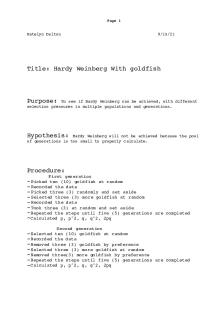Lab report of Hardy Weinberg PDF

| Title | Lab report of Hardy Weinberg |
|---|---|
| Author | Katelyn Dalton |
| Course | Cell Biology With Lab |
| Institution | University of New Haven |
| Pages | 4 |
| File Size | 59.5 KB |
| File Type | |
| Total Downloads | 4 |
| Total Views | 146 |
Summary
Gold fish lab of Hardy Weinberg done in Ap Bio...
Description
Page 1
Katelyn Dalton
9/15/21
Title: Hardy Weinberg With goldfish
Purpose:
To see if Hardy Weinberg can be achieved, with different selection pressures in multiple populations and generations.
Hypothesis:
Hardy Weinberg will not be achieved because the pool of generations is too small to properly calculate.
Procedure: First generation
- Picked ten (10) goldfish at random - Recorded the data - Picked three (3) randomly and set aside - Selected three (3) more goldfish at random - Recorded the data - Took three (3) at random and set aside - Repeated the steps until five (5) generations are completed - Calculated p, p^2, q, q^2, 2pq Second generation
- Selected ten (10) goldfish at random - Recorded the data - Removed three (3) goldfish by preference - Selected three (3) more goldfish at random - Removed three(3) more goldfish by preference - Repeated the steps until five (5) generations are completed - Calculated p, p^2, q, q^2, 2pq
Page 2
Data Collection:
Selection one (Equilibrium)
Generations
Pretzel
Goldfish
1
6
4
2
5
5
3
5
5
4
3
7
5
5
5
Selection Two (Natural Selection)
Generations
Pretzel
Goldfish
1
4
6
2
5
5
3
6
4
4
7
3
5
8
2
Sources of Error With the two populations given and used, even with multiple generations, the area of analysis is too small to see if Hardy Weinberg could be achieved, it is also very unlikely Hardy Weinberg could even achieve with more generations. With the population with the natural selection pressure, it’s even harder to see if Hardy Weinberg could be achieved with only 5 generations.
Page 3
Conclusion:
In the two populations given my hypothesis was connected to the results of the lab, that Hardy Weinberg equilibrium can not be produced. To create equilibrium no random mating and no selection pressures take place which is almost impossible in the natural world, and even in controlled lab environment. In population one there was there instances where there are five (5) pretzel and five (5) goldfish, with could in theory cause the frequency to stay the same, but they where not all even which more than likely causing the frequency to not be the same. In populations two, with the selection pressure of favoritism, only one generations had five (5) pretzel and five (5) causing it to be almost impossible for the frequency to stay the same for all generations to come. In conclusion, Hardy Weinberg equilibrium is almost impossible to be achieved with a small amount of generation numbers, even in a lab environment with no natural pressure it was still not created.
Page 4...
Similar Free PDFs

Lab report of Hardy Weinberg
- 4 Pages

Hardy Weinberg lab report
- 11 Pages

LP hardy weinberg
- 15 Pages

Hardy Weinberg lab - Pop Gen Lab
- 4 Pages

Koi Fish Hardy-Weinberg
- 8 Pages

Genetika populasi hardy-weinberg
- 13 Pages

Hardy weinberg questions
- 3 Pages

Legge di Hardy-Weinberg
- 2 Pages

Hardy Weinberg problems
- 2 Pages

AP Bio Applying Hardy-Weinberg
- 4 Pages

Hardy-weinberg Green Monkey Key
- 1 Pages

03-Lei de Hardy-Weinberg
- 9 Pages

Hardy Weinberg Problems T FB
- 3 Pages

Chapitre 1 Modèle de Hardy-Weinberg
- 11 Pages
Popular Institutions
- Tinajero National High School - Annex
- Politeknik Caltex Riau
- Yokohama City University
- SGT University
- University of Al-Qadisiyah
- Divine Word College of Vigan
- Techniek College Rotterdam
- Universidade de Santiago
- Universiti Teknologi MARA Cawangan Johor Kampus Pasir Gudang
- Poltekkes Kemenkes Yogyakarta
- Baguio City National High School
- Colegio san marcos
- preparatoria uno
- Centro de Bachillerato Tecnológico Industrial y de Servicios No. 107
- Dalian Maritime University
- Quang Trung Secondary School
- Colegio Tecnológico en Informática
- Corporación Regional de Educación Superior
- Grupo CEDVA
- Dar Al Uloom University
- Centro de Estudios Preuniversitarios de la Universidad Nacional de Ingeniería
- 上智大学
- Aakash International School, Nuna Majara
- San Felipe Neri Catholic School
- Kang Chiao International School - New Taipei City
- Misamis Occidental National High School
- Institución Educativa Escuela Normal Juan Ladrilleros
- Kolehiyo ng Pantukan
- Batanes State College
- Instituto Continental
- Sekolah Menengah Kejuruan Kesehatan Kaltara (Tarakan)
- Colegio de La Inmaculada Concepcion - Cebu

